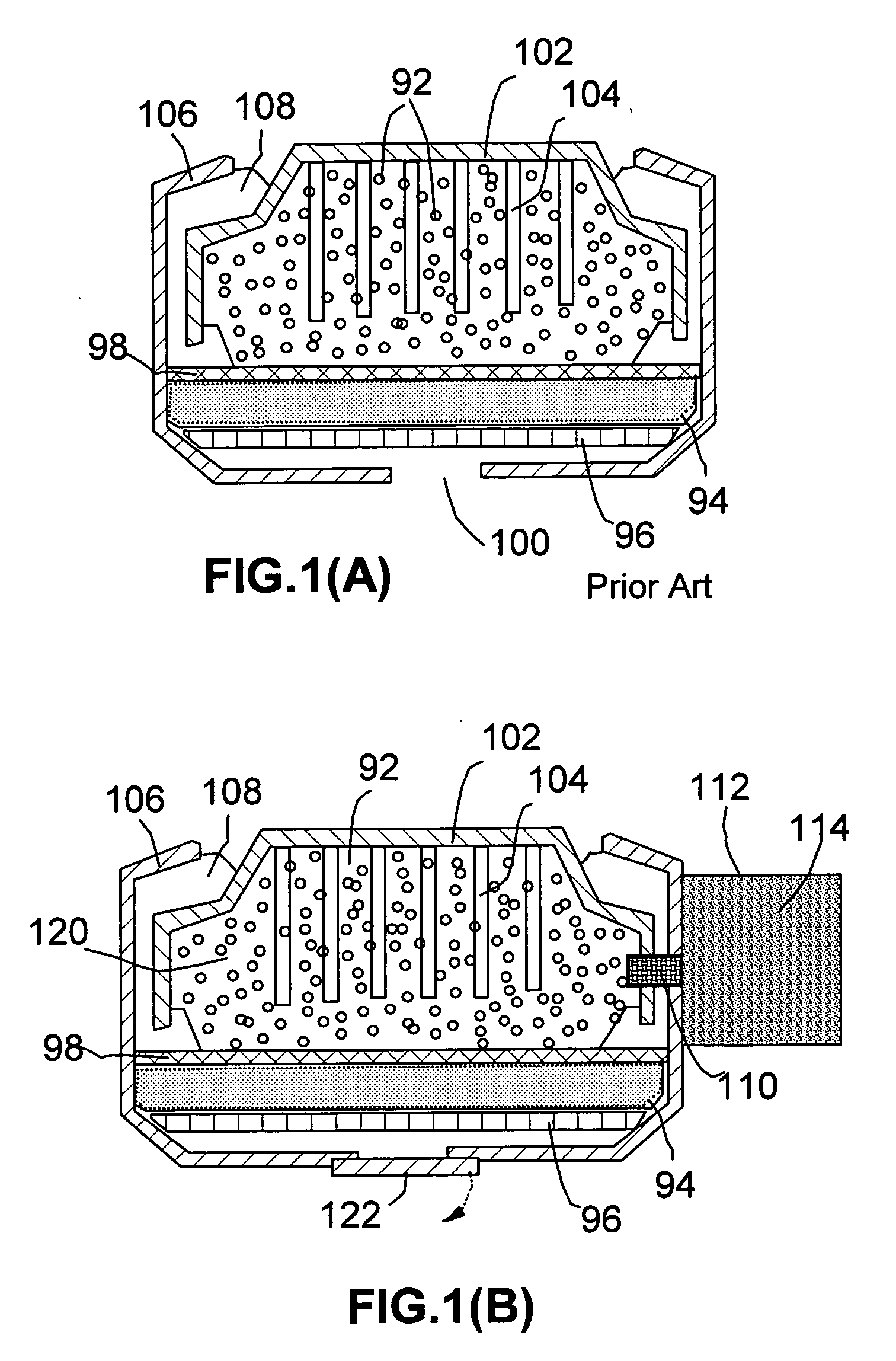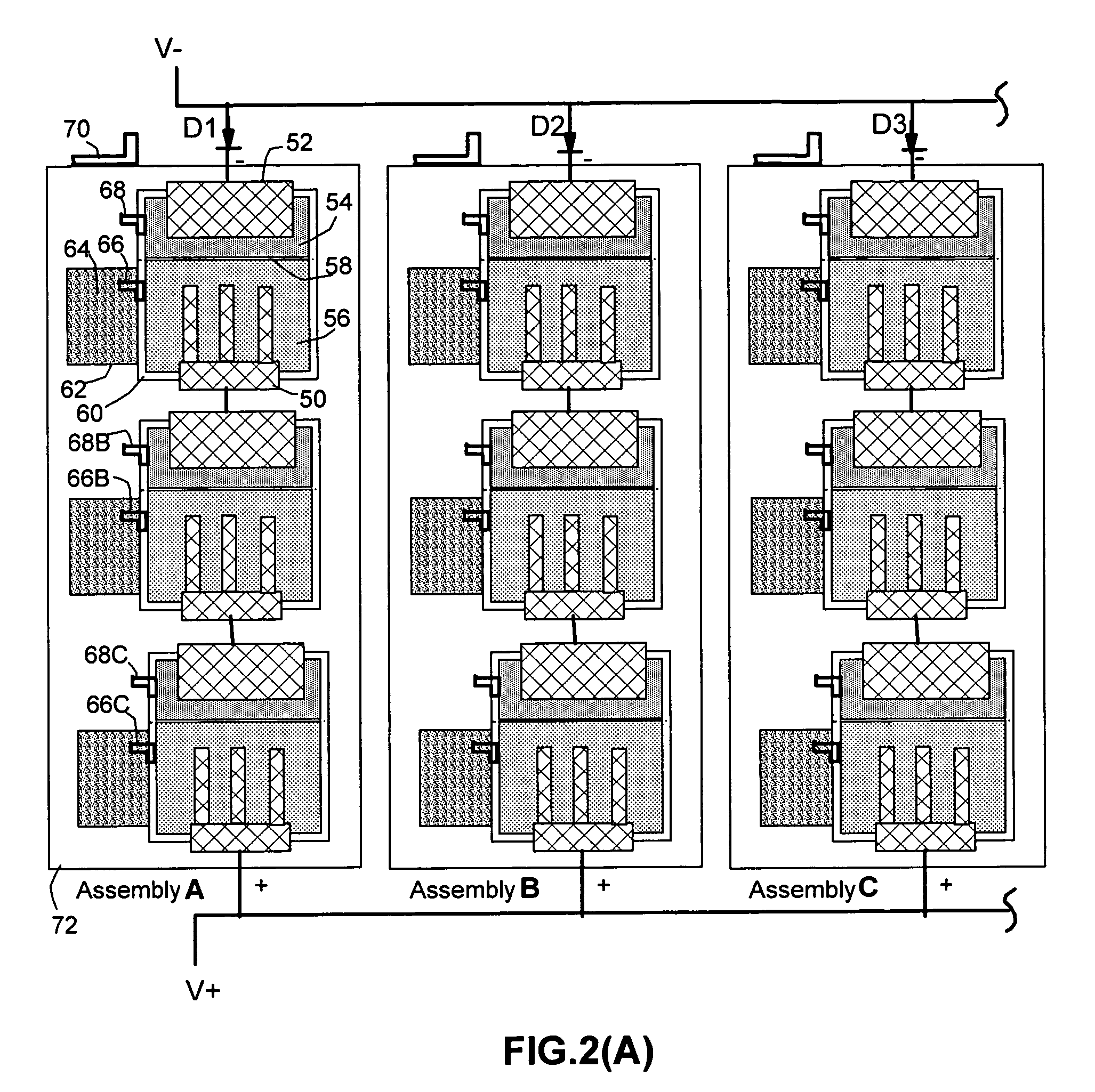Metal-air battery system with programmed-timing activation
a fuel cell and metal-air technology, applied in the direction of batteries, primary cell maintenance/servicing, cell components, etc., can solve the problems of reducing the useful life of batteries, and inefficient use of anodes
- Summary
- Abstract
- Description
- Claims
- Application Information
AI Technical Summary
Benefits of technology
Problems solved by technology
Method used
Image
Examples
example 1
[0087] To further illustrate the battery design concepts inherent in the present invention, let us use a current zinc-air battery (Model EF-M2-33 for use in Motorola StarTAC mobile phone) as an example. The battery is rated at a power capacity of 3300 mAh×3.6 v=11.88 watt-hours. The battery is designed to provide a “talk time” of 6-16 hours or “stand-by” time of 80-350 hours (3.33-14.6 days). With an energy density of 980 watt-hours / Kg for Zn, this capacity requires at least 12.1 grams of Zn (i.e., 11.88 / 980=0.0121 Kg). In actuality, much more Zn was used in this commercially available battery. The total weight of this battery (Zn plus overhead weights) is rated at 79 grams.
[0088] In order to extend the “stand-by” time to 30 days, an approximate Zn anode amount of 25 grams will be required, provided that all 25 grams of Zn is fully utilized. Unfortunately, by simply doubling the amount of unprotected Zn in anode did not double the “stand-by” time, presumably due to t...
example 2
[0089] In accordance with the present invention, a new Zn-air battery was designed in such a way that the first 12 grams of Zn, in a fine powder form (average particle size of 8-20 μm), was packed together and attached to a copper-based current collector. This first 12 grams of Zn in contact with the KOH electrolyte Oust like in a conventional Zn-air cell) was packed in a first cell assembly and provides the first 14 days of stand-by time to a mobile phone. This first 12 grams of Zn in the present invention is referred to as the “initial-stage” anode active material. The next 13 grams of Zn, also in the form of fine particles but initially isolated from KOH solution, was used in the second cell assembly and got activated after slightly less than 14 days (allowing KOH solution to come in contact with the Zn particles). These 13 grams of Zn provided approximately 15.5 days of stand-by time, making the total stand-by time now up to 29.5 days. This was possible due to the fact that, wit...
example 3
[0090] Again, 12 grams of Zn was used as the first-stage anode active material and additional 13 grams of Zn was used as the second-stage anode active material, as in the above Example 2. In the present Example 3, however, the second-stage anode material was initially isolated from KOH solution and air was not admitted into the cell during the first stage. At the end of the first 14 days, KOH was allowed to flow into the anode compartment and air was admitted into the cell. These extra 13 grams of Zn were found to provide up to approximately 16.5 days of operation. The fact that the controlled-timing activation functions to expose an anode active material to the electrolyte liquid and oxygen at the correct timing with the purpose of protecting an anode active material against corrosion, passivation, and self-discharge makes this class of exceptionally long operating life batteries technically feasible and economically viable.
PUM
| Property | Measurement | Unit |
|---|---|---|
| period of time | aaaaa | aaaaa |
| output voltage | aaaaa | aaaaa |
| output voltage | aaaaa | aaaaa |
Abstract
Description
Claims
Application Information
 Login to View More
Login to View More - R&D
- Intellectual Property
- Life Sciences
- Materials
- Tech Scout
- Unparalleled Data Quality
- Higher Quality Content
- 60% Fewer Hallucinations
Browse by: Latest US Patents, China's latest patents, Technical Efficacy Thesaurus, Application Domain, Technology Topic, Popular Technical Reports.
© 2025 PatSnap. All rights reserved.Legal|Privacy policy|Modern Slavery Act Transparency Statement|Sitemap|About US| Contact US: help@patsnap.com



